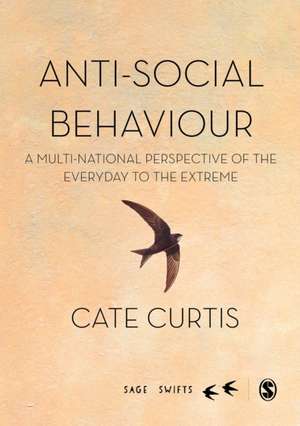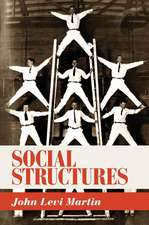Anti-Social Behaviour: A multi-national perspective of the everyday to the extreme: SAGE Swifts
Autor Cate Curtisen Limba Engleză Hardback – 22 feb 2016
- Cathy Coleborne, University of Newcastle, Australia
“A timely work given the present global shift in the use of social media and violence. Cate Curtis’ book serves as a multinational mini-meta-analytic review of anti-social behaviours”
- Richard Langford, University of Hawaii West Oahu
“Cate Curtis’ coverage in this book is breath-taking. It is centred on challenging taken for granted assumptions concerning the three Rs: ‘risk’, ‘resilience’ and ‘recovery’ whilst questioning what is respectable everyday activities and extreme behaviour in culture and society.”
- Shane Blackman, Canterbury Christ Church University
Cate Curtis seeks to disrupt assumptions about anti-social behaviour by bringing together a host of key concepts and theories applicable to the field. Going beyond individualised discussions, the book explores broader concepts such as the social construction of ‘anti-social behaviour’, ‘risk’ and ‘resilience’, and the social contents and influences under which these are most likely to occur.
An excellent companion for researchers and postgraduate students in of anti-social behaviour across criminology, social psychology, sociology and social work.
Din seria SAGE Swifts
-
 Preț: 425.65 lei
Preț: 425.65 lei -
 Preț: 426.43 lei
Preț: 426.43 lei -
 Preț: 425.76 lei
Preț: 425.76 lei -
 Preț: 426.10 lei
Preț: 426.10 lei -
 Preț: 426.59 lei
Preț: 426.59 lei - 22%
 Preț: 358.90 lei
Preț: 358.90 lei -
 Preț: 246.38 lei
Preț: 246.38 lei -
 Preț: 246.66 lei
Preț: 246.66 lei -
 Preț: 408.59 lei
Preț: 408.59 lei -
 Preț: 425.39 lei
Preț: 425.39 lei -
 Preț: 426.52 lei
Preț: 426.52 lei -
 Preț: 485.13 lei
Preț: 485.13 lei - 15%
 Preț: 512.67 lei
Preț: 512.67 lei - 5%
 Preț: 472.05 lei
Preț: 472.05 lei - 15%
 Preț: 466.52 lei
Preț: 466.52 lei - 22%
 Preț: 372.16 lei
Preț: 372.16 lei - 15%
 Preț: 511.01 lei
Preț: 511.01 lei -
 Preț: 468.37 lei
Preț: 468.37 lei - 22%
 Preț: 358.70 lei
Preț: 358.70 lei - 22%
 Preț: 358.26 lei
Preț: 358.26 lei - 15%
 Preț: 422.36 lei
Preț: 422.36 lei -
 Preț: 481.49 lei
Preț: 481.49 lei - 22%
 Preț: 371.74 lei
Preț: 371.74 lei - 15%
 Preț: 466.03 lei
Preț: 466.03 lei - 15%
 Preț: 448.92 lei
Preț: 448.92 lei - 18%
 Preț: 685.93 lei
Preț: 685.93 lei -
 Preț: 115.47 lei
Preț: 115.47 lei -
 Preț: 123.24 lei
Preț: 123.24 lei - 22%
 Preț: 358.26 lei
Preț: 358.26 lei
Preț: 511.83 lei
Preț vechi: 602.15 lei
-15% Nou
Puncte Express: 768
Preț estimativ în valută:
97.94€ • 106.72$ • 82.53£
97.94€ • 106.72$ • 82.53£
Carte tipărită la comandă
Livrare economică 23 aprilie-07 mai
Preluare comenzi: 021 569.72.76
Specificații
ISBN-13: 9781473915770
ISBN-10: 1473915775
Pagini: 120
Dimensiuni: 148 x 210 x 22 mm
Greutate: 0.3 kg
Ediția:1
Editura: SAGE Publications
Colecția Sage Publications Ltd
Seria SAGE Swifts
Locul publicării:London, United Kingdom
ISBN-10: 1473915775
Pagini: 120
Dimensiuni: 148 x 210 x 22 mm
Greutate: 0.3 kg
Ediția:1
Editura: SAGE Publications
Colecția Sage Publications Ltd
Seria SAGE Swifts
Locul publicării:London, United Kingdom
Recenzii
In seven chapters, Antisocial Behaviour neatly and succinctly takes readers through ways to understand and interpret the label of ‘antisocial’ behaviour in a wider context, showing how it is socially, historically and culturally produced as well as understood in professional health and policing or correctional contexts. In her innovative SWIFT intervention, Curtis also grapples with new forms of antisocial behaviour as imagined in online spaces, and examines the new ways in which communities and governments have sought to police, ‘correct’, or limit this type of behaviour. The text offers a crisp insightful synthesis of core issues in social psychology.
A timely work given the present global shift in the use of social media and violence. Cate Curtis’ book serves as a multinational mini-meta-analytic review of anti-social behaviours. Each chapter builds developmentally by topic to the concluding chapter that outlines various intervention alternatives. This is a book that will fit well in both undergraduate and graduate courses in psychology, family studies, education (social justice), social welfare, nursing, criminal justice, political science, behavioural economics, sociology, and anthropology.
Curtis takes the reader through the perceptions and concepts of what we have come to think of as anti-social behaviour, drawing on the work of Emile Durkheim, Sigmund Freud and Robert Merton amongst others. She examines the risk and protective factors related to aberrant behaviour, focusing primarily on the social roots but also considering biological factors. She also considers the role of new technologies and and social media concluding that the public and media perception of ASB often fail to match the evidence and the current levels of concern might be reasonably seen as a moral panic.
This book will be an extremely useful resource across many disciplines, not least criminal justice, social welfare, behavioural economics, psychology, sociology and anthropology as it provides a very good introduction to and explanation of what anti-social behaviour (ASB) is and, indeed, what it is not.
Cate Curtis’ coverage in this book on Anti-social behaviour is breath-taking. It is centred on challenging taken for granted assumptions concerning the three Rs: ‘risk’, ‘resilience’ and ‘recovery’ whilst questioning what is respectable everyday activities and extreme behaviour in culture and society. Her investigation into social behaviour is fast paced and detailed assessing diverse and oppositional arguments as she moves towards a complex assessment of multiple factors, which shape the meaning of anti-social behaviour. Written in an accessible style with scholarly depth, the book will be touchstone for students and researchers in sociology, criminology, media and cultural studies, politics and social policy.
Cate Curtis examines anti-social behaviour, starting with the 1998 UK legislation (and the conduct it was designed to suppress), but she expands the scope of ‘‘anti-social behaviour’’ to include other western jurisdictions and other, more serious, forms of offending. She adopts an international, comparative approach and combines seminal and contemporary scholarship from the traditions of social psychology, social work, sociology, and criminology. Remarkably, she does all of this in a mere 87 pages of text organised into seven succinct chapters. In the sixth century BCE, Aesop observed that ‘good things come in small packages’. He might be right.
A timely work given the present global shift in the use of social media and violence. Cate Curtis’ book serves as a multinational mini-meta-analytic review of anti-social behaviours. Each chapter builds developmentally by topic to the concluding chapter that outlines various intervention alternatives. This is a book that will fit well in both undergraduate and graduate courses in psychology, family studies, education (social justice), social welfare, nursing, criminal justice, political science, behavioural economics, sociology, and anthropology.
Curtis takes the reader through the perceptions and concepts of what we have come to think of as anti-social behaviour, drawing on the work of Emile Durkheim, Sigmund Freud and Robert Merton amongst others. She examines the risk and protective factors related to aberrant behaviour, focusing primarily on the social roots but also considering biological factors. She also considers the role of new technologies and and social media concluding that the public and media perception of ASB often fail to match the evidence and the current levels of concern might be reasonably seen as a moral panic.
This book will be an extremely useful resource across many disciplines, not least criminal justice, social welfare, behavioural economics, psychology, sociology and anthropology as it provides a very good introduction to and explanation of what anti-social behaviour (ASB) is and, indeed, what it is not.
Cate Curtis’ coverage in this book on Anti-social behaviour is breath-taking. It is centred on challenging taken for granted assumptions concerning the three Rs: ‘risk’, ‘resilience’ and ‘recovery’ whilst questioning what is respectable everyday activities and extreme behaviour in culture and society. Her investigation into social behaviour is fast paced and detailed assessing diverse and oppositional arguments as she moves towards a complex assessment of multiple factors, which shape the meaning of anti-social behaviour. Written in an accessible style with scholarly depth, the book will be touchstone for students and researchers in sociology, criminology, media and cultural studies, politics and social policy.
Cate Curtis examines anti-social behaviour, starting with the 1998 UK legislation (and the conduct it was designed to suppress), but she expands the scope of ‘‘anti-social behaviour’’ to include other western jurisdictions and other, more serious, forms of offending. She adopts an international, comparative approach and combines seminal and contemporary scholarship from the traditions of social psychology, social work, sociology, and criminology. Remarkably, she does all of this in a mere 87 pages of text organised into seven succinct chapters. In the sixth century BCE, Aesop observed that ‘good things come in small packages’. He might be right.
Cuprins
Introduction
Perceptions and Concepts: Constructing Anti-Social Behaviour
The Politics of Anti-Social Behaviour: Policies and Values
Ordinary Anti-Social Behaviour: Everyday Hassles
Anti-Social Behaviour as a Social Activity: Group Processes
New Technology, New Media: Transmitting New Behaviour?
Prevention, Intervention and Punishment: Risk, Resilience and Recovery
Perceptions and Concepts: Constructing Anti-Social Behaviour
The Politics of Anti-Social Behaviour: Policies and Values
Ordinary Anti-Social Behaviour: Everyday Hassles
Anti-Social Behaviour as a Social Activity: Group Processes
New Technology, New Media: Transmitting New Behaviour?
Prevention, Intervention and Punishment: Risk, Resilience and Recovery












